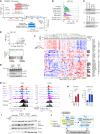Reversal of viral and epigenetic HLA class I repression in Merkel cell carcinoma
- PMID: 35775490
- PMCID: PMC9246387
- DOI: 10.1172/JCI151666
Reversal of viral and epigenetic HLA class I repression in Merkel cell carcinoma
Abstract
Cancers avoid immune surveillance through an array of mechanisms, including perturbation of HLA class I antigen presentation. Merkel cell carcinoma (MCC) is an aggressive, HLA-I-low, neuroendocrine carcinoma of the skin often caused by the Merkel cell polyomavirus (MCPyV). Through the characterization of 11 newly generated MCC patient-derived cell lines, we identified transcriptional suppression of several class I antigen presentation genes. To systematically identify regulators of HLA-I loss in MCC, we performed parallel, genome-scale, gain- and loss-of-function screens in a patient-derived MCPyV-positive cell line and identified MYCL and the non-canonical Polycomb repressive complex 1.1 (PRC1.1) as HLA-I repressors. We observed physical interaction of MYCL with the MCPyV small T viral antigen, supporting a mechanism of virally mediated HLA-I suppression. We further identify the PRC1.1 component USP7 as a pharmacologic target to restore HLA-I expression in MCC.
Keywords: MHC class 1; Oncology; Proteomics; Skin cancer.
Figures






References
-
- Chang CC, et al. Classical and nonclassical HLA class I antigen and NK cell-activating ligand changes in malignant cells: current challenges and future directions. Adv Cancer Res. 2005;93:189–234. - PubMed
Publication types
MeSH terms
Substances
Grants and funding
- P01 CA203655/CA/NCI NIH HHS/United States
- P50 CA101942/CA/NCI NIH HHS/United States
- R01 HL131768/HL/NHLBI NIH HHS/United States
- U24 CA270823/CA/NCI NIH HHS/United States
- U24 CA224331/CA/NCI NIH HHS/United States
- R01 CA155010/CA/NCI NIH HHS/United States
- U01 CA214125/CA/NCI NIH HHS/United States
- R50 CA251956/CA/NCI NIH HHS/United States
- P30 CA006516/CA/NCI NIH HHS/United States
- U24 CA210986/CA/NCI NIH HHS/United States
- R50 CA243777/CA/NCI NIH HHS/United States
- T32 HG002295/HG/NHGRI NIH HHS/United States
- T32 GM007753/GM/NIGMS NIH HHS/United States
- K12 CA090354/CA/NCI NIH HHS/United States
- T32 GM144273/GM/NIGMS NIH HHS/United States
- R21 CA216772/CA/NCI NIH HHS/United States
- R35 CA232128/CA/NCI NIH HHS/United States
- R01 CA173023/CA/NCI NIH HHS/United States
LinkOut - more resources
Full Text Sources
Other Literature Sources
Medical
Molecular Biology Databases
Research Materials

